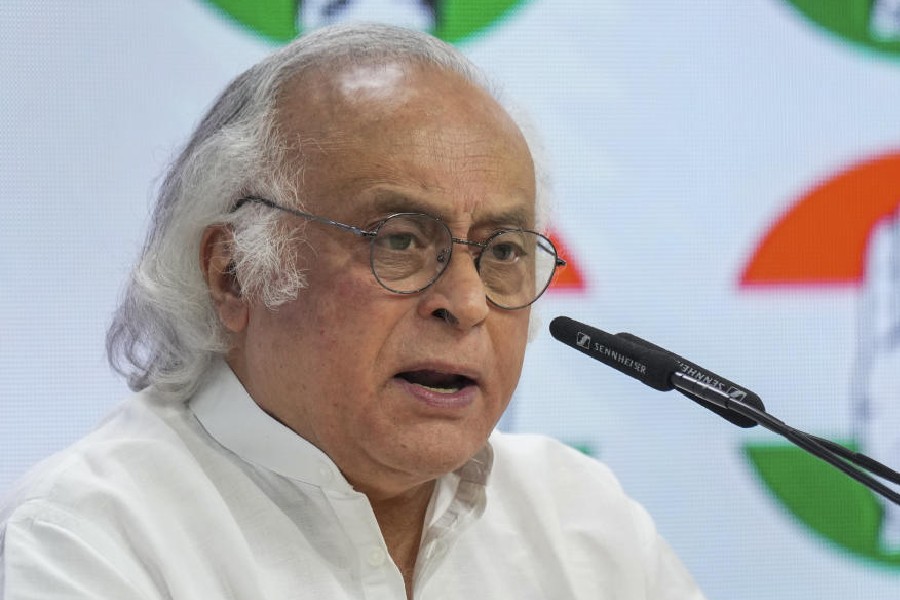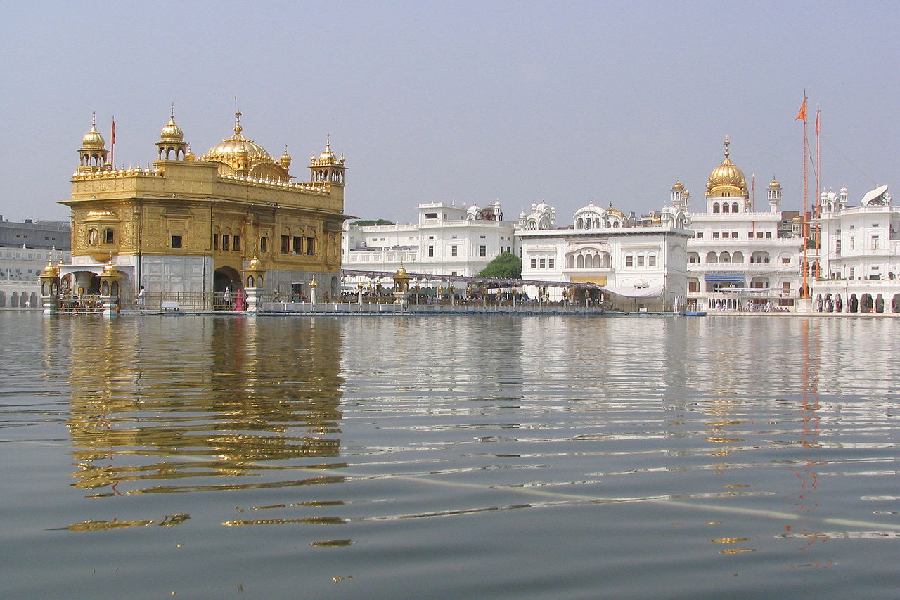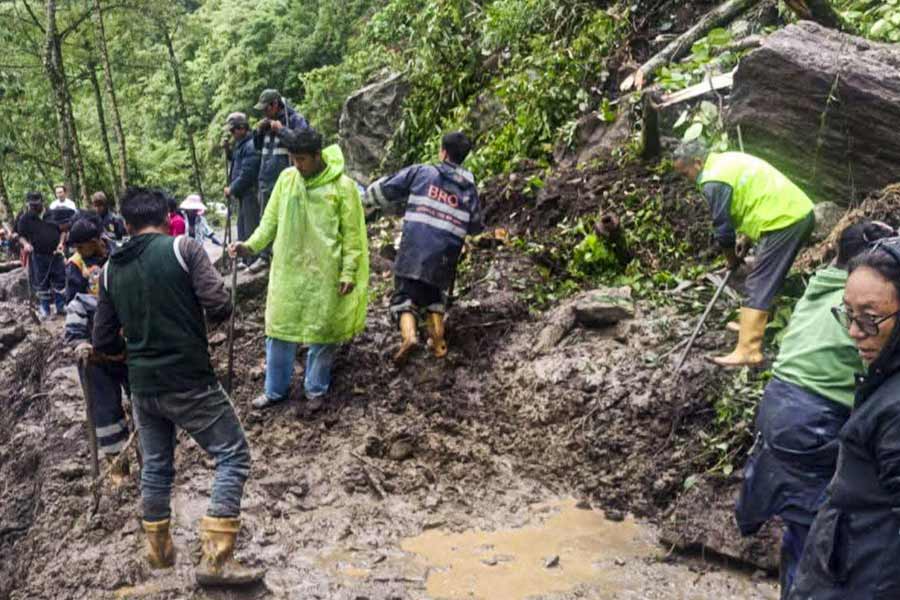 |
| Artistes on the sets of the Assamese film Rong. (Inset) Set designer Manjula Barua creates her own props. Pictures by UB Photos |
Creating a new home, a new neighbourhood, a new world, is all in a day?s work for the film fraternity?s set designers. From huts with thatched roofs to a plush hotel lobby, the set designer?s imagination cuts across economic and regional barriers to provide a silent background to the artistes? performance.
Manjula Barua, the set designer of the multi-starrer Rong, had to bring in even her own dining table, crockery, cabinets and other upholstery to do up the sets of the film. The film, which has 16 sets and all the scenes shot on the floor of a studio, had been intricately and painstakingly designed by her.
Barua, who has designed sets in over 10 successful films like Nayak, Daag, Kanyadaan, Barood, Bidhata, Dinabandhu and Rong, says, ?I have no professional training and make good use my aesthetic sense. I started off with the film Hiya Diya Niya where I was given an empty house and convert it into an aristocratic household.?
However, she had to work amid limitations, which plague the industry. ?We have to work within a limited budget. In the big metros, we can hire the furniture but here we have to procure them on our own. Many a times, I dismantle and recreate many of the sets and change the colour schemes accordingly.?
Film sets are an emerging trend in the Assamese film industry. Back in the seventies and eighties, directors often shot in real houses or villages in order to save money. However, in the nineties all this changed, with producers realising that the more lavish the sets, the greater the potential box office returns.
Filmmaker Bidyut Chakravarty says, ?Earlier, people did not understand the importance of sets. Shooting on the studio floor is a recent phenomenon. Even now, 80 per cent of the work is still done on real locations to cut costs but a realistic shot is still not perfect here.?
?Sets, costumes, lighting and colour scheme are very important and we are yet to adopt it professionally. Moreover, if we can work on the sets, our travelling costs can be reduced and all the shots can be done in a compact manner under one roof. As a whole, creative planning is yet to be developed,? adds Chakravarty.
Veteran actor Biju Phukan, too, prefers to work on an artificially created set inside a studio. ?I feel more comfortable in a studio as it offers more flexibility, both professionally and technically.?
Jyoti Prasad Agarwalla?s Joymati, made in the thirties, is an excellent example of experimental set designing. Filmmaker Gautam Bora points out, ?The concept of an Ahom Swargadeo?s palace was well-researched by Agarwalla and he evolved the concept of a South Asian architectural design.?
Phukan feels that it is a welcome change that many young and talented set designers have come to the fore.
Veteran set designer Nuruddin Ahmed?s world revolves around the stage. He has completed 25 years of set designing in both celluloid and mobile theatre and feels that Assamese cinema has undergone a sea change in terms of shooting in a studio.
?I am not restricted to a four-walled structure but can create my own area on stage, experiment with colours, and enhance or tone down the content of the play according to the needs of the director and the characters,? he says.
Is there a specific design to his work plan? ?The graph begins to form in my mind even as the director narrates the script and talking about his ideas. Colour plays a very important role in the overall look of a set. For example, in a comedy we have to enhance the characters? performance by a mix of the right colours, props and lights. My set must be of help to the character and a source of pleasure to the mainstream filmgoer who pays good money for a ticket,? explains Ahmed.
?The work done by our set designers is indeed a miracle considering the limitations that they work in,? says Phukan. Most Bollywood sets are created in Mumbai?s vast studios where hundreds of workers create different sets made from materials such as plywood and polystyrene. These sets are then quickly dismantled to make way for another production.
Whereas America leads the way in computer-generated set design, India is catching up. Bollywood special effects are not up to Hollywood standards but with a wealth of IT professionals, the use of digitally produced sets is fast catching up in India too.
Film critic Chandan Sarmah, however, feels that Assamese cinema still has a long way to go in terms of set designing. ?We have many trained artists from reputed institutes of the country, but they have to get a proper film to explore their talent,? he adds.
?A set designer is associated with the film right from the beginning, when the director and producer are studying the script and working out how to turn it into something that will appeal to audience,? explains Sarmah.
A set designer?s life is not easy by any standards. Long hours, dealing with temperamental artistes and demanding directors, managing people and property in the best possible way, are just a few of the challenges.
Veteran set designer Phatik Barua says, ?You can be certain that no one will reach out to help you. You have to prove yourself.? An eye for extreme detail and a mind capable of translating the director?s vision into a camera-worthy set is the task of the set designer.?
The most challenging exercise for Barua was when he had designed 26 sets on a single floor in 15 days for the film Kushal by Jahnu Barua. It was also by far the most expensive set he had created at a cost of more than Rs 3 lakh.
?I also had a tough time doing a technically difficult set design for the film Papori where the camera zooms in and out of the window,? recalls Barua.
Actor Pranjal Saikia laments that these set designers who create the visual package that draws the audience to the theatre often go unnoticed. ?They work under severe constraints. The filmmakers cannot invest much as they are not sure of the returns as people have virtually stopped going to cinemas due to the prevailing law and order situation.?
Says Saikia, ?The state government should institute awards for these artists in order to inspire them to go for better innovations. It would also come as a succour to the industry which is on the verge of dying.?










